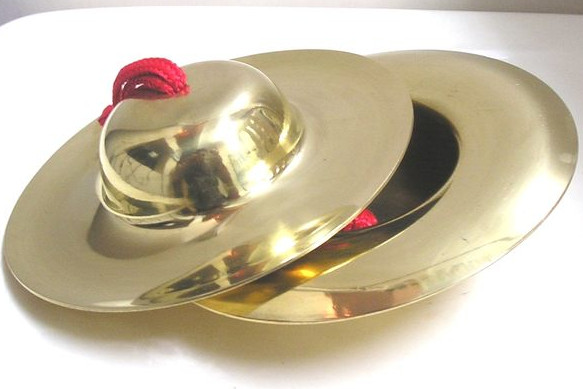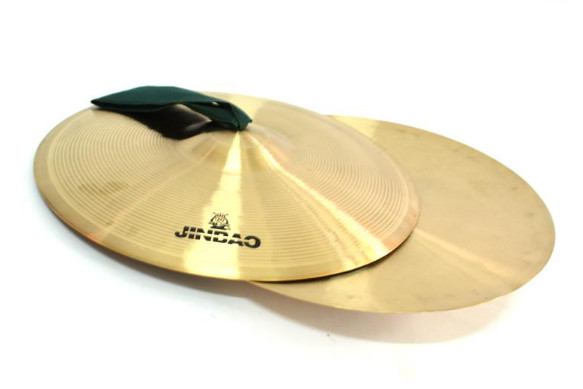The difference between cymbals and cymbals in ethnic musical instruments
4080 views · Organized by 长恭 on 2022-02-25
Cymbals and cymbals are not the same musical instrument, and their origins, shapes, and performances are very different.
Cymbal: The cymbal is a Chinese musical instrument derived from the cymbal. Legend has it that in the "Fan King Pressing Music" painted by the Song Dynasty, there is an image of him accompanying the dance of the Hu people, which can be seen for a long time.
Cymbal: Made of brass, bowl-shaped, the appearance is very similar to the cymbal, and the cymbal body is generally smaller, so the folks call the small cymbal as the cymbal. The cymbal surface is relatively flat, slightly thinner than the cymbal, slightly thicker than the cymbal, and the bowl in the middle has a small round top. Usually the diameter of the noodles is 12 cm to 20 cm, the diameter of the bowl is 2/5 of the diameter of the noodles, the height of the bowl is 1.5 cm to 2.5 cm, the top of the bowl is drilled with silk cloth, and both sides are a pair.
Cymbals: commonly used in Buddhist and Taoist music and entertainment and publicity activities. It is also an important rhythm instrument in Tibetan Opera, Peking Opera, Henan Opera, Jin Opera and other operas, minority folk bands, Hebei blowing songs, Shifan gongs and drums, Fuzhou Pinghua, Fujian Nanyin, Chaozhou gongs and drums and other instrumental ensembles and dance accompaniment.
Origin of cymbals and cymbals
Cymbals: Cymbals originated in West Asia, first in Egypt and Syria, and later in ancient countries such as Persia and Rome; in the East, they were first seen in India, and then in Central Asia. According to the "Book of Northern Emperor. Shenwu Ji" records: cymbals are about Around 350 AD, it was introduced into the Central Plains of my country with "Tianzhu Music".Cymbal: The cymbal is a Chinese musical instrument derived from the cymbal. Legend has it that in the "Fan King Pressing Music" painted by the Song Dynasty, there is an image of him accompanying the dance of the Hu people, which can be seen for a long time.

Cymbal and Cymbal Shapes
Cymbal: A round copper percussion instrument with two round copper pieces, the center of which is bulged into a hemisphere, with a hole in the center, which can be held through silk strips, etc., and the two pieces strike each other for sound.Cymbal: Made of brass, bowl-shaped, the appearance is very similar to the cymbal, and the cymbal body is generally smaller, so the folks call the small cymbal as the cymbal. The cymbal surface is relatively flat, slightly thinner than the cymbal, slightly thicker than the cymbal, and the bowl in the middle has a small round top. Usually the diameter of the noodles is 12 cm to 20 cm, the diameter of the bowl is 2/5 of the diameter of the noodles, the height of the bowl is 1.5 cm to 2.5 cm, the top of the bowl is drilled with silk cloth, and both sides are a pair.

Different occasions
Cymbals: not only used in national music, local drama, wind and drum music and gongs and drums, but also widely used in folk songs and dances, entertainment and publicity activities of all ethnic groups.Cymbals: commonly used in Buddhist and Taoist music and entertainment and publicity activities. It is also an important rhythm instrument in Tibetan Opera, Peking Opera, Henan Opera, Jin Opera and other operas, minority folk bands, Hebei blowing songs, Shifan gongs and drums, Fuzhou Pinghua, Fujian Nanyin, Chaozhou gongs and drums and other instrumental ensembles and dance accompaniment.
Involving musical instruments
The cymbal (pinyin: chǎ) is a Chinese percussion instrument, that is, a small cymbal. Also known as cymbals, hinges, etc. There are two common types of Chinese folk cymbals: brass cymbals and iron cymbals. Because the cymbal is an instrument with no fixed pitch, generally speaking, the sound of the small cymbal is the highest, followed by the middle cymbal, and the sound of the large cymbal is the lowest.
The cymbal (pinyin: Bó) is a percussion instrument with no fixed pitch. Bronze, with a bulge in the center, they are made of two round copper plates that strike each other. It is usually played together with gongs and drums to form a gong and drum team. Chinese cymbals also appear in Western music, but their size is usually less than 11 cm.
Guess you like
Organized by 拙 on 2022-06-23
In the ancient city of Shouzhou, many gong and drum teams are active, and gong and drum performances are held during the festivals.
read >>
Organized by 一杯清酒 on 2022-06-22
On June 18, the 2022 Xianfeng County Cultural and Natural Heritage Day and the Cultural and Ecological Protection Experimental Zone construction achievements publicity and display activities were held in the Tangya Tusi City Site Scenic Spot.
read >>
Organized by 雨童 on 2022-03-21
Bai folk instrumental music mainly includes sanxian music, suona wind and percussion music, cave scripture music, etc. In addition, there are also ancient music and tunes played by bamboo flute, mouth spring, wood leaf and so on.
read >>
Organized by 向日葵 on 2022-03-15
In March, another national event will bloom in Zhengzhou. The 2022 China Intangible Cultural Heritage Protection Annual Conference will be held in Zhengzhou from March 21 to 24.
read >>
Organized by 肖毅 on 2022-03-09
"Joke Tan" is a form of folk singing, which has the form of opera. Its performances are often interspersed in the middle of Meihu plays, appearing at the request of the audience.
read >>
Hot news
- 01 Echoes of history and artistic narration of music: In-depth analysis and cultural connotation exploration of the famous Pipa song "House of Flying Faces"
- 02 The difference between cymbals and cymbals in ethnic musical instruments
- 03 Pipa famous song "Overlord Unarmor" : historical picture and heroic lament in music
- 04 "Drunken Fishing Singing Late" -- the perfect fusion of t"High Mountains and Flowing Water" -- the profound friendship and artistic spirit behind the ancient qin music of Boya's mournihe taste of life and the natural artistic conception in the Guqin music
- 05 Sunset Flute and Drum - A Deep Interpretation of the Poetic and Artistic Conception and Music Narration in Ancient Pipa Songs
 渝公网安备 50010702504639号
渝公网安备 50010702504639号